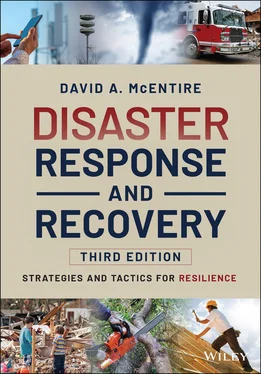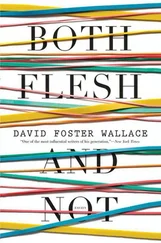David A. McEntire - Disaster Response and Recovery
Здесь есть возможность читать онлайн «David A. McEntire - Disaster Response and Recovery» — ознакомительный отрывок электронной книги совершенно бесплатно, а после прочтения отрывка купить полную версию. В некоторых случаях можно слушать аудио, скачать через торрент в формате fb2 и присутствует краткое содержание. Жанр: unrecognised, на английском языке. Описание произведения, (предисловие) а так же отзывы посетителей доступны на портале библиотеки ЛибКат.
- Название:Disaster Response and Recovery
- Автор:
- Жанр:
- Год:неизвестен
- ISBN:нет данных
- Рейтинг книги:5 / 5. Голосов: 1
-
Избранное:Добавить в избранное
- Отзывы:
-
Ваша оценка:
- 100
- 1
- 2
- 3
- 4
- 5
Disaster Response and Recovery: краткое содержание, описание и аннотация
Предлагаем к чтению аннотацию, описание, краткое содержание или предисловие (зависит от того, что написал сам автор книги «Disaster Response and Recovery»). Если вы не нашли необходимую информацию о книге — напишите в комментариях, мы постараемся отыскать её.
The new edition of the standard textbook in the field, updated with new studies and practical guidelines for reacting to the complexities of today’s disasters Disaster Response and Recovery: Strategies and Tactics for Resilience
Disaster Response and Recovery: Strategies and Tactics for Resilience, Third Edition
Disaster Response and Recovery — читать онлайн ознакомительный отрывок
Ниже представлен текст книги, разбитый по страницам. Система сохранения места последней прочитанной страницы, позволяет с удобством читать онлайн бесплатно книгу «Disaster Response and Recovery», без необходимости каждый раз заново искать на чём Вы остановились. Поставьте закладку, и сможете в любой момент перейти на страницу, на которой закончили чтение.
Интервал:
Закладка:
Other examples of panic flight have been witnessed during large religious gatherings. In 2005, 841 people were killed and another 323 were injured while attending a religious gathering at the Al Kadhimiya Mosque in Baghdad. Someone falsely reported the presence of a suicide bomber, and people began to evacuate the building and nearby area. Hundreds of people stampeded toward a bridge, which broke and fell into the Tigris River. A similar situation took place in Mecca, Saudi Arabia in 2006. 363 people were crushed and killed on the final day of the Hajj (pilgrimage). The incident began when some individuals accidentally tripped over their luggage. This created some fear in those nearby and caused them to scatter. Panic flight does not occur very often, but it can turn deadly as these cases suggest.
1.4.2 Riots
Riots are another type of civil/conflict hazards. Riotsare large disturbances where people engage in antisocial behavior. They may begin as social protests but they are different than political demonstrations since this conduct includes rock throwing, looting, tipping over vehicles, starting fires and attacking law enforcement personnel. That is to say, social protesters and their opponents may peaceful protests initially, but the tense emotions may sometimes spark riots. These riots reveal serious disagreements about political decisions, economic circumstances, racial tensions and/or cultural conflict. Other factors, such as drunk fans after the Super Bowl, may also trigger riots. Whatever the cause, these events can damage property, disrupt business activities and hurt the economy. They may also produce a large number of injuries and even death.
There have been several notable riots in the United States, including the Watts Riot in Los Angeles in 1965. This episode began when an officer pulled over an African American man who was alleged to have been driving erratically. In another racially charged situation, four police officers appeared to have used excessive force against Rodney King in Sylmar, California on March 3, 1991. The incident was caught on tape, but the police officers were not convicted of any crime. Many people believed that the police beating was both unnecessary and brutal. Others believed the legal system was biased when the verdict was made public. As a result, on April 29, 1992, thousands of people took to the streets to illustrate their dismay. Fifty individuals were killed, hundreds were injured, and over 12,000 people were arrested. Damage was in the millions of dollars.
Another riot occurred in Seattle in 1999 when environmentalists and others protested the policies of the World Trade Organization. During a 4‐day period, people not only marched and heckled police but disabled busses and broke windows. As the violence ensued, it became apparent that law enforcement agencies in Seattle were not fully prepared. They were caught off guard by the demonstration that turned violent. The situation after the George Zimmerman trial in 2013 was dramatically different. The resulting protests were limited in number and were generally peaceful. The police in Florida and around the nation were better prepared for potential riots after the tragic death of a young black man.

https://www.shutterstock.com/image‐photo/los‐angeles‐may‐30‐2020‐police‐1745189957
In 2020 and 2021, a series of riots affected the United States and the nation’s capital. After decades of systemic institutional racism and a police officer’s kneeling on George Floyd’s neck on May 25, 2020, which resulted in his death, thousands of people took to the streets and some of the demonstrations turned violent in Minneapolis‐Saint Paul. Two people were killed and over $500,000 in property damage resulted from looting and arson. The situation prompted similar protests around the country for several months. Perhaps as many as 25 people died and countless others were injured during these protests and accompanying riots. Damages from vandalism, arson, and looting may have tallied as much as $2 billion during the summer months in 2020. In a counter‐protest or riot due to the Republican loss of the November 2020 Presidential election, many of Donald Trump’s supporters marched on the capitol building in Washington, D.C. Some even stormed this important landmark and institution, which caused police to use weapons to protect House and Senate representatives. Five people were killed in the clash (one from a shooting, one from being hit in the head with a fire extinguisher, and the others from a stroke, heart attack, and other medical emergency). These events clearly illustrate the need for further planning and preparedness for mass violence if political protests take a turn for the worse.
1.4.3 Mass Shootings
Mass shootings are one example of civil/conflict hazards. Because of constitutional rights, people have armed themselves with weapons in the United States. Unfortunately, a small portion of these individuals have shot others due to disagreements or for unknown reasons. It appears that these events have sadly become more common over the past two decades. Shootings at schools occurred frequently in the late 1990s in Pearl, MS; Paducah, KN; Jonesborough, AR; Springfield, OR.; Conyers, GA; Atlanta, GA and Pelham, AL. Other events have been especially devastating:
On April 20, 1999, two disgruntled students entered Columbine High School in Jefferson County, Colorado. Besides placing and detonating several bombs in and around this educational facility, the students fired into the crowded cafeteria and library areas. By the time the perpetrators committed suicide, 12 students and 1 teacher were killed, and 24 others were injured. The incident prompted a national review of how to respond to mass shootings, and the lessons gleaned have had a major impact on law enforcement policies and procedures.
On September 15, 1999, a gunman walked into youth rally and discharged to weapons into the congregation at a church in Fort Worth, Texas. Seven people were killed. Numerous others were injured and had to be quickly taken to area hospitals.
In October of 2002, there were several sniper shootings that occurred over a period of several weeks at numerous locations in Maryland, Virginia, and Washington, DC. One man and one minor were responsible for killing 10 people and injuring 3 others. These serial murderers prompted a massive investigation and illustrated the difficulty of capturing those involved in such episodes of violence.
On July 20, 2012, a mass shooting occurred inside a movie theater in Aurora, Colorado. A gunman used multiple weapons of weapons to attack his victims, ultimately killing 12 people and wounding over 50 others.
On December 14, 2012, a horrific school shooting took place in Connecticut at Sandy Hook Elementary. Twenty children and six adults were murdered by a 20‐year‐old gunman. Those that survived the mass shooting and some emergency personnel that rushed to the scene to help have had an extremely difficult time coping with this traumatic event.
On September 16, 2013, a man who was discharged from the military entered a Washington Navy Yard. He opened fire, killing 12 and injuring several others.
On February 14, 2018, a lone gunman used a semi‐automatic rifle to shoot numerous people at the Majory Stoneman Douglas High School in Parkland, Florida. This event became the deadliest school shooting in U.S. history and promoted many reforms in gun laws in this state and elsewhere across America.
One December 29, 2019, a man pulled out a shotgun in a church in White Settlement, Texas. The man shot and killed two individuals and would have likely killed others, but he was taken out by two volunteer members of the church’s security team who returned fire with their own weapons. The Texas Department of Public Safety described their quick actions as “heroic.”
Читать дальшеИнтервал:
Закладка:
Похожие книги на «Disaster Response and Recovery»
Представляем Вашему вниманию похожие книги на «Disaster Response and Recovery» списком для выбора. Мы отобрали схожую по названию и смыслу литературу в надежде предоставить читателям больше вариантов отыскать новые, интересные, ещё непрочитанные произведения.
Обсуждение, отзывы о книге «Disaster Response and Recovery» и просто собственные мнения читателей. Оставьте ваши комментарии, напишите, что Вы думаете о произведении, его смысле или главных героях. Укажите что конкретно понравилось, а что нет, и почему Вы так считаете.












